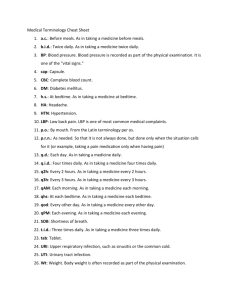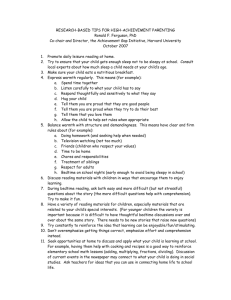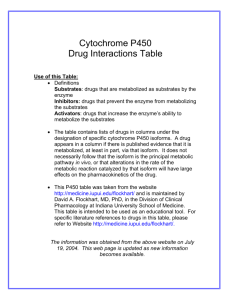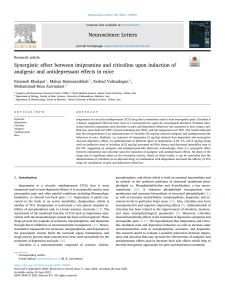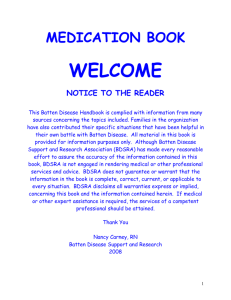imipramine(im-ip-ra-meen){Apo
advertisement
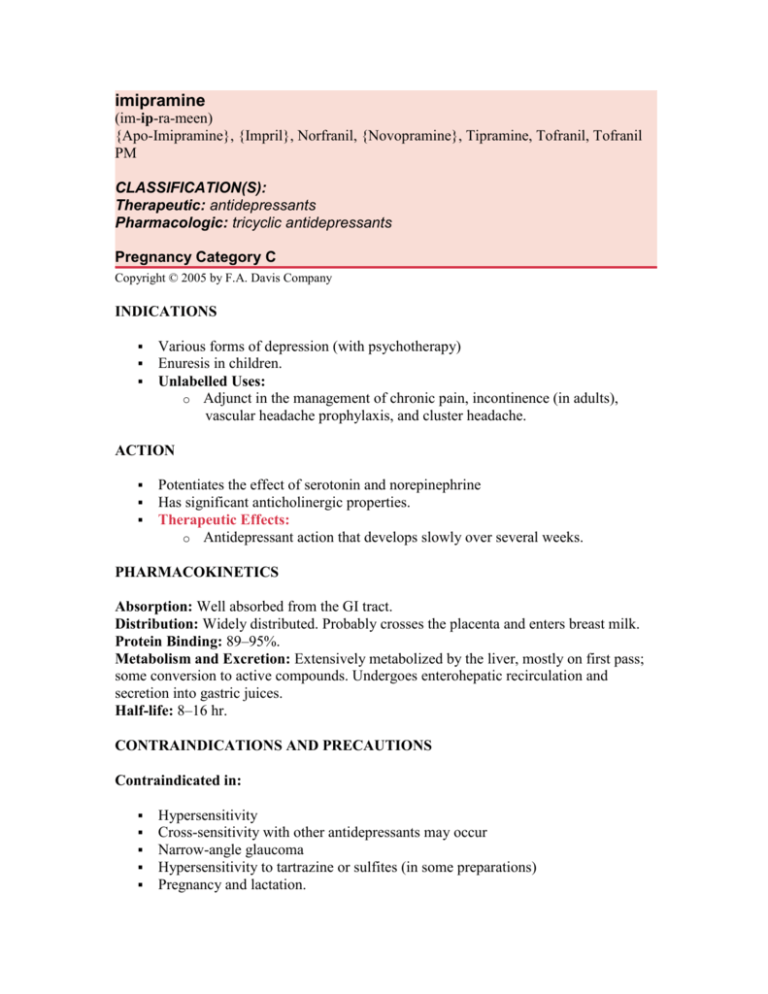
imipramine
(im-ip-ra-meen)
{Apo-Imipramine}, {Impril}, Norfranil, {Novopramine}, Tipramine, Tofranil, Tofranil
PM
CLASSIFICATION(S):
Therapeutic: antidepressants
Pharmacologic: tricyclic antidepressants
Pregnancy Category C
Copyright © 2005 by F.A. Davis Company
INDICATIONS
Various forms of depression (with psychotherapy)
Enuresis in children.
Unlabelled Uses:
o Adjunct in the management of chronic pain, incontinence (in adults),
vascular headache prophylaxis, and cluster headache.
ACTION
Potentiates the effect of serotonin and norepinephrine
Has significant anticholinergic properties.
Therapeutic Effects:
o Antidepressant action that develops slowly over several weeks.
PHARMACOKINETICS
Absorption: Well absorbed from the GI tract.
Distribution: Widely distributed. Probably crosses the placenta and enters breast milk.
Protein Binding: 89–95%.
Metabolism and Excretion: Extensively metabolized by the liver, mostly on first pass;
some conversion to active compounds. Undergoes enterohepatic recirculation and
secretion into gastric juices.
Half-life: 8–16 hr.
CONTRAINDICATIONS AND PRECAUTIONS
Contraindicated in:
Hypersensitivity
Cross-sensitivity with other antidepressants may occur
Narrow-angle glaucoma
Hypersensitivity to tartrazine or sulfites (in some preparations)
Pregnancy and lactation.
Use Cautiously in:
Geriatric patients (more susceptible to adverse reactions)
Pre-existing cardiovascular disease
Geriatric men with prostatic hyperplasia (more susceptible to urinary retention)
Seizures or history of seizure disorder.
ADVERSE REACTIONS AND SIDE EFFECTS*
*CAPITALS indicate life threatening; underlines indicate most frequent.
CNS: drowsiness, fatigue, agitation, confusion, hallucinations, insomnia.
EENT: blurred vision, dry eyes.
CV: ARRHYTHMIAS, hypotension, ECG changes.
GI: constipation, dry mouth, nausea, paralytic ileus.
GU: urinary retention.
Derm: photosensitivity.
Endo: gynecomastia.
Hemat: blood dyscrasias.
INTERACTIONS
Drug–Drug:
May cause hypotension, tachycardia, and potentially fatal reactions when used
with MAO inhibitors (avoid concurrent use—discontinue 2 wk prior to
imipramine)
Concurrent use with SSRI antidepressants may result in increased toxicity and
should be avoided ( fluoxetine should be stopped 5 wk before)
Concurrent use with clonidine may result in hypertensive crisis and should be
avoided
Imipramine is metabolized in the liver by the cytochrome P450 2D6 enzyme and
its action may be affected by drugs that compete for metabolism by this enzyme
including other antidepressants, phenothiazines, carbamazepine, class 1C
antiarrhythmics ( propafenone, flecainide); when used concurrently, dosage
reduction of one or the other or both may be necessary. Concurrent use of other
drugs that inhibit the activity of the enzyme, including cimetidine, quinidine,
amiodarone, and ritonavir, may result in increased effects of imipramine
May prevent the therapeutic response to guanethidine
Concurrent use with levodopa may result in delayed/decreased absorption of
levodopa or hypertension
Blood levels and effects may be decreased by rifamycins
Concurrent use with sparfloxacin increases the risk of adverse cardiovascular
reactions
Additive CNS depression with other CNS depressants including alcohol,
antihistamines, clonidine, opioid analgesics, and sedative/hypnotics
Barbiturates may alter blood levels and effects
Adrenergic andanticholinergic side effects may be additive with other agents
having these properties
Phenothiazines or oral contraceptives increase levels and may cause toxicity
Cigarette smoking ( nicotine) may increase metabolism and alter effects.
Drug–Natural:
Concomitant use of kava, valerian, skullcap, chamomile, or hops can increase
CNS depression
Increased anticholinergic effects with angel’s trumpet, jimson weed, and
scopolia.
ROUTE AND DOSAGE
PO (Adults): 25–50 mg 3–4 times daily (not to exceed 300 mg/day); total daily
dose may be given at bedtime.
PO (Geriatric Patients): 25 mg at bedtime initially, up to 100 mg/day in divided
doses.
PO (Children >12 yr): Antidepressant—25–50 mg/day in divided doses (not to
exceed 100 mg/day).
PO (Children 6–12 yr): Antidepressant—10–30 mg/day in 2 divided doses.
PO (Children >6 yr): Enuresis—25 mg once daily 1 hr before bedtime; increase
if necessary by 25 mg at weekly intervals to 50 mg in children <12 yr, up to 75
mg in children >12 yr.
IM (Adults): Up to 100 mg/day in divided doses (not to exceed 300 mg/day).
AVAILABILITY
Tablets: 10 mgRx, 25 mgRx , 50 mgRx, 75 mgRx
Cost: Tofranil—10 mg $34.89/100, 25 mg $56.82/100, 50 mg
$100.84/100;generic— 10 mg $5.92/100, 25 mg $7.84/100, 50 mg $10.83/100
Capsules: 75 mgRx, 100 mgRx, 125 mgRx, 150 mgRx
Injection: 12.5 mg/mlRx. .
TIME/ACTION PROFILE (antidepressant effect)
PO, IM
ONSET
PEAK
DURATION
hours
2–6 wk
weeks
NURSING IMPLICATIONS
ASSESSMENT
General: Monitor blood pressure and pulse rate prior to and during initial
therapy.
o Monitor baseline and periodic ECGs in elderly patients or patients with
heart disease and before increasing dosage with children treated for
enuresis. May cause prolonged PR and QT intervals and may flatten T
waves.
Depression: Assess mental status frequently. Confusion, agitation, and
hallucinations may occur during initiation of therapy and may require dosage
reduction. Monitor mood changes. Assess for suicidal tendencies, especially
during early therapy. Restrict amount of drug available to patient.
Enuresis: Assess frequency of bedwetting throughout therapy.
Pain: Assess location, duration, and severity of pain periodically throughout
therapy.
Lab Test Considerations: Assess leukocyte and differential blood counts and
renal and hepatic functions prior to and periodically during prolonged or highdose therapy.
o Serum levels may be monitored in patients who fail to respond to usual
therapeutic dose. Therapeutic plasma concentration range for depression
is 150–300 ng/ml.
o May cause alterations in blood glucose levels.
Toxicity and Overdose: Symptoms of acute overdose include disturbed
concentration, confusion, restlessness, agitation, seizures, drowsiness, mydriasis,
arrhythmias, fever, hallucinations, vomiting, and dyspnea.
o Treatment of overdose includes gastric lavage, activated charcoal, and a
stimulant cathartic. Maintain respiratory and cardiac function (monitor
ECG for at least 5 days) and temperature. Medications may include
digoxin for CHF, antiarrhythmics, and anticonvulsants.
POTENTIAL NURSING DIAGNOSES
Coping, ineffective (Indications).
Urinary elimination, impaired (Indications).
IMPLEMENTATION
General: Do not confuse imipramine with desipramine.
o Dose increases should be made at bedtime because of sedation. Dose
titration is a slow process; may take weeks to months. May be given as a
single dose at bedtime to minimize sedation during the day.
PO: Administer medication with or immediately following a meal to minimize
gastric irritation.
IM: May be slightly yellow or red in color. Crystals may develop if solution is
cool; place ampule under warm running water for 1 min to dissolve.
PATIENT/FAMILY TEACHING
General: Instruct patient to take medication exactly as directed. If a dose is
missed, take as soon as possible unless almost time for next dose; if regimen is a
single dose at bedtime, do not take in the morning because of side effects. Advise
patient that drug effects may not be noticed for at least 2 wk. Abrupt
discontinuation may cause nausea, vomiting, diarrhea, headache, trouble sleeping
with vivid dreams, and irritability.
o May cause drowsiness and blurred vision. Caution patient to avoid driving
and other activities requiring alertness until response to drug is known.
o Instruct patient to notify health care professional if visual changes occur.
Inform patient that periodic glaucoma testing may be needed during longterm therapy.
o Caution patient to change positions slowly to minimize orthostatic
hypotension.
o Advise patient to avoid alcohol or other CNS depressant drugs during
therapy and for at least 3–7 days after therapy has been discontinued.
o Instruct patient to notify health care professional if urinary retention
occurs or if dry mouth or constipation persists. Sugarless candy or gum
may diminish dry mouth and an increase in fluid intake or bulk may
prevent constipation. If symptoms persist, dose reduction or
discontinuation may be necessary. Consult health care professional if dry
mouth persists for more than 2 wk.
o Caution patient to use sunscreen and protective clothing to prevent
photosensitivity reactions.
o Inform patient of need to monitor dietary intake, as possible increase in
appetite may lead to undesired weight gain. Inform patient that increased
amounts of riboflavin in the diet may be required; consult health care
professional.
o Advise patient to notify health care professional of medication regimen
prior to treatment or surgery.
o Therapy for depression is usually prolonged. Emphasize the importance of
follow-up exams to evaluate progress.
Children: Inform parents that the side effects most likely to occur include
nervousness, insomnia, unusual tiredness, and mild nausea and vomiting. Notify
health care professional if these symptoms become pronounced.
o Advise parents to keep medication out of reach of children to prevent
inadvertent overdose.
EVALUATION
Effectiveness of therapy can be demonstrated by:
Increased sense of well-being
o Renewed interest in surroundings
o Increased appetite
o Improved energy level
o
Improved sleep in patients treated for depression. Patient may require 2–6
wk of therapy before full therapeutic effects of medication are noticeable
Control of bedwetting in children >6 yr
Decrease in chronic neurogenic pain.

